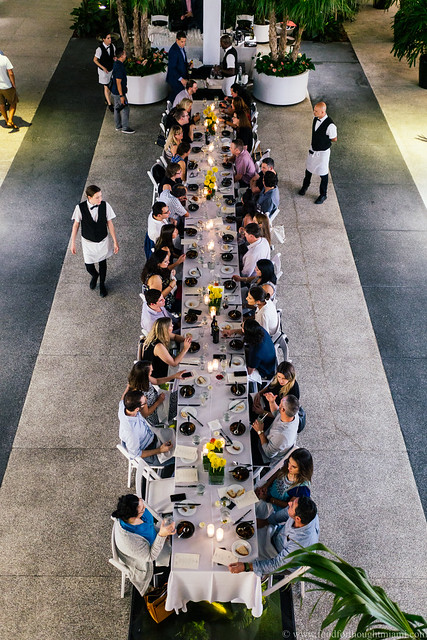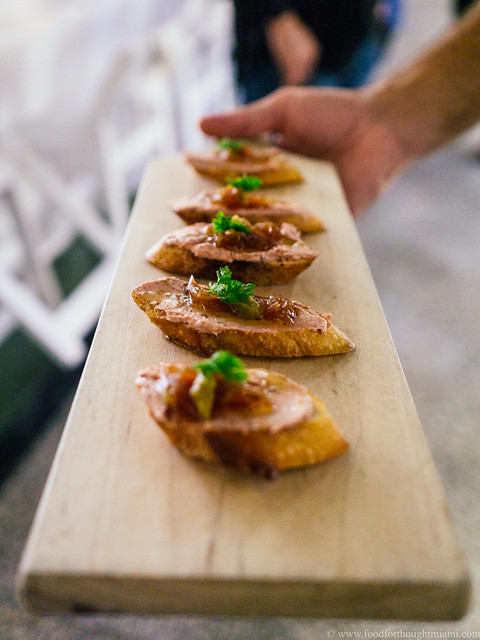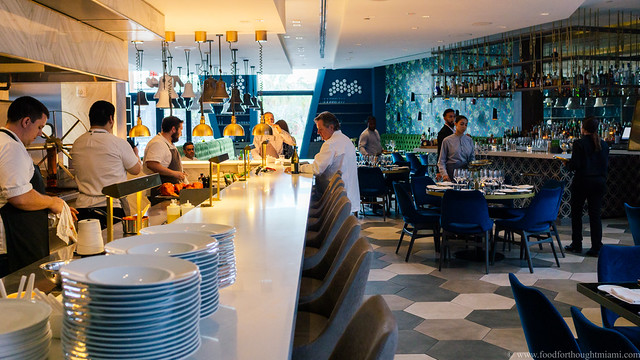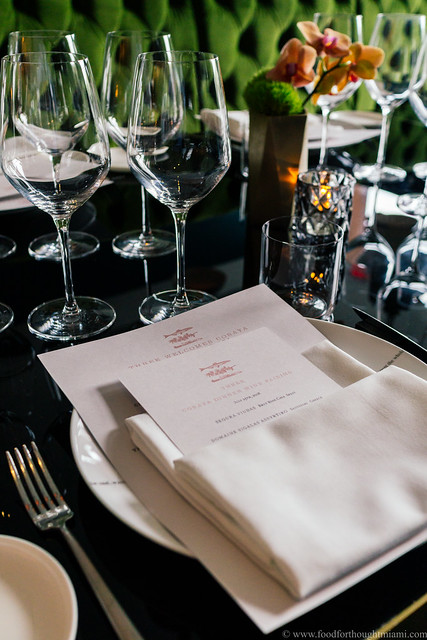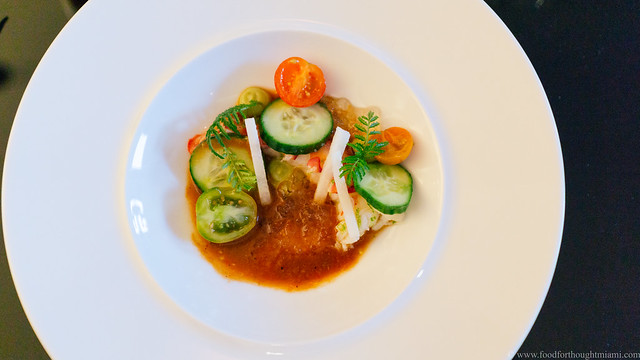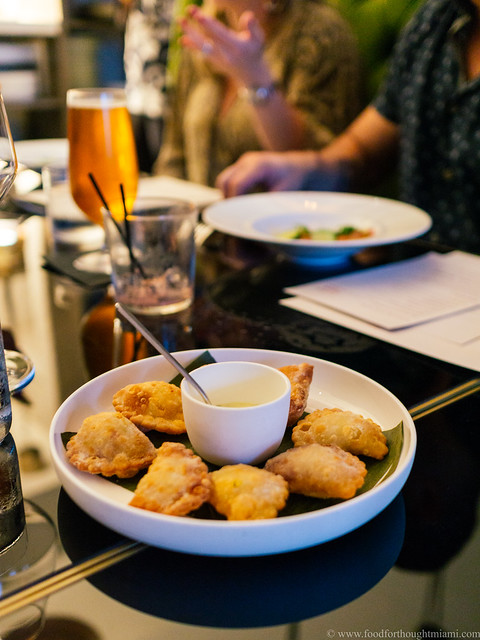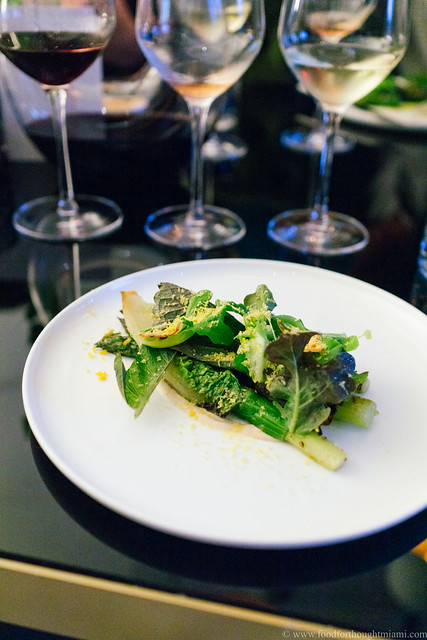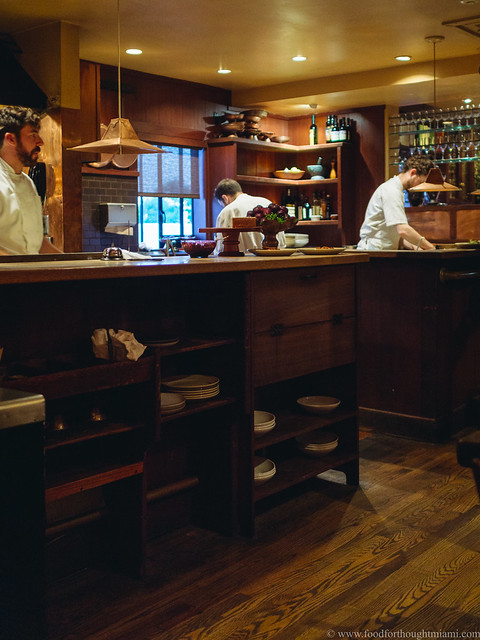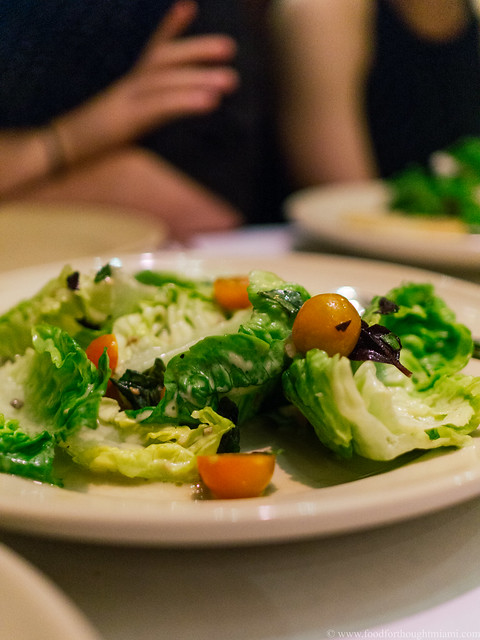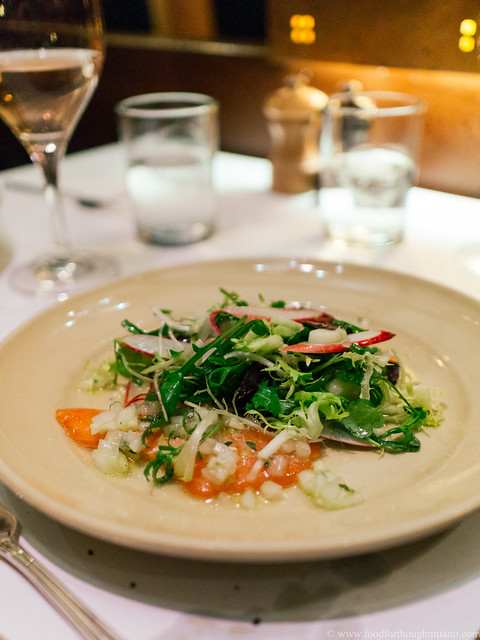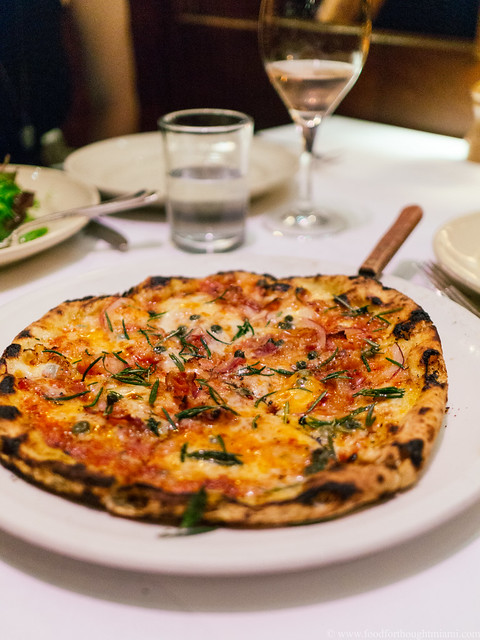I'm a big fan of collaborations. When you put two creative minds together, good things are bound to happen. Yet many "collaborative" dinner events turn out to not really involve all that much actual teamwork. Sure, the chefs will communicate about a menu and ingredients, and decide who is going to do what. But more often than not, they're ping-pong-ing courses back and forth, rather than working together to create dishes that are a genuine combined effort.
Which is one of the things that made our Cobaya dinner last week with chefs Julian Baker of Le Zoo, and Anthony Micari of Makoto, so special: each dish seemed to bear the imprint of both chefs, and both kitchens.
They had some advantages in doing so. The French bistro and contemporary Japanese restaurant are neighbors, both housed in the posh Bal Harbour Shops. They are also siblings of a sort, both under the management of Stephen Starr's Starr Restaurant Group.[1] And they're both Cobaya alumni, in a way: Chef Baker hosted Cobaya Experiment #40 while he was chef at Toscana Divino in Brickell, and Makoto's namesake, head chef Makoto Okuwa, was the host for Cobaya Experiment #32.
For Experiment #75, the two chefs set up a table for thirty of us right between their two restaurants: smack in the middle of the breezeway of Bal Harbour Shops over a glassed-in koi pond that runs through the center. Amidst the shoppers browsing the Dolce & Gabbana couture and Fendi purses, they served a menu that combined, in each dish, the flavors and ingredients and techniques of France and Japan. Here's a recap:
(You can see all my pictures in this Cobaya Le Zoo Makoto flickr set)
Guinea Pigs starting to make their way in for Cobaya Experiment #75.
A snack as guests arrived, and a preview of what's to come: toasted baguettes smeared with a rich, and very French, chicken liver mousse, topped with a zingy, spicy, and very Japanese, yuzu kosho marmalade.
"Toro Niçoise." Chef Micari marinated block cuts of fatty tuna sashimi in soy sauce, toro zuke, style. Chef Baker brought the flavors of the Mediterranean: pickled haricots verts, tomatoes, niçoise olives, slivered radishes, a delicate squash blossom. Someone threw in some fudgy, Szechuan-spiced egg yolk, which was a very good idea. This was a great start.
"Japanese Bouillabaisse." Chef Micari brought some seafood from Tsukiji Market in Tokyo: gorgeous head-on shrimp, silky scallops, delicate baby calamari. It arrived at the table in a bowl with a rice puff rubbed with saffron aioli, the traditional accompaniment to a Provençal bouillabaisse. The dish was then finished with a tableside pour of a rich, heady, spicy seafood stew that had been enriched with red aka miso.
(continued ...)
Wednesday, November 21, 2018
Monday, September 17, 2018
Cobaya Three with Norman Van Aken
Let me just get this out of the way: Norman Van Aken has always been something of an idol of mine. One of my formative food experiences was at his restaurant A Mano, which he opened in the Betsy Ross Hotel on South Beach (now known just as The Betsy) in 1991. A Mano was Van Aken's first venture in Miami after making a name for himself at Louie's Backyard in Key West, and it was a great restaurant: fancy but not stuffy, bringing classical technique and refinement to the ingredients and flavors of Latin America and the Caribbean. If that sounds old hat now, it's a testament to the influence of Van Aken and several other chefs of that generation who helped to democratize, in a way, what we think of as fine dining.[1]
I celebrated my 25th birthday at A Mano the next year, and can still recall the "Down Island French Toast" with seared foie gras and a savory citrus caramel, the massive bone-in ribeye "gaucho" steak studded with slivers of garlic and jalapeño, and a dessert that topped ice cream with bananas cooked in rum and sugar, then laced it all with a spicy-sweet chile jelly.[2] Fresh out of law school and just starting my career, in a position for the first time in my life to really celebrate the joys of good eating on my own dime, this was how I wanted to do it.
I went back to Van Aken's restaurants as often as I could – the more modestly priced Stars and Stripes Café in the front of the Betsy Ross more frequently than A Mano, and then later his longtime flagship Norman's in Coral Gables. I bought his cookbooks, and cooked from them. And I followed many of the paths they illuminated – other chefs and writers – along the way learning a good bit of what I know about food now.
So how often do you get to ask one of your idols to cook for you? We've been trying for years to make a Cobaya dinner with Norman Van Aken happen. It finally did in late July, and it was worth the wait. This was a particularly special one for me – another dinner I'll remember for a long time. Here are some notes and pictures.
(You can see all my pictures in this Cobaya Three with Norman Van Aken flickr set).
Three, in Wynwood, actually may be my favorite of the venues Van Aken has operated since he came up US-1 from Key West.[3] Part of the Wynwood Arcade, it has a dining room that glows with plush, richly hued greens and blues, a long dining counter along the open kitchen, plus a rooftop bar (No. 3 Social) which is where we started the evening.
After plying us with cocktails – a choice of the "Hit the Deck" with vodka, habanero syrup, watermelon and mint, or the "Norman's Revenge" with tequila, lime, jalapeño and a black salt rim – we were led back downstairs to the dining room, which we'd taken over for the evening.
We started with a dish inspired by a classic Mexican[4] hangover cure, "Vuelve a la Vida," a ceviche-style seafood salad with supposedly restorative powers. This one was more refined than most, combining a chilled lobster tail, a cocktail-sauce like spicy tomato dressing, a mezcal gelée (a little hair of the dog), avocado purée, and fresh cherry tomatoes, cucumbers and crunchy jicama batons. Some crispy empanadas rode along sidecar.
I loved the next dish, which put together fat, flavorful grilled asparagus spears,[5] wispy garden lettuces, a smoked benne seed dressing, and shavings of preserved citrus. It's not always easy to give depth of flavor to vegetable dishes, but this one accomplished it.[6]
(continued ...)
Monday, July 9, 2018
Chez Panisse | Berkeley, California
Some places aren't just restaurants; they're institutions. Chez Panisse certainly falls in that category. Its founder, Alice Waters, is widely regarded as the patron saint of the "farm-to-table" movement: the restaurant, which she opened in 1971, made the sourcing of local ingredients a cornerstone long before that term was commonly used, much less beaten to death.[1] And generations of restaurants since have followed suit.
My last visit to Chez Panisse must have been about twenty years ago.[2] It doesn't seem to have changed much at all, even though the two-story Arts and Crafts style space got a major facelift about five years ago after a fire. (No doubt it helped that the architect who first designed the restaurant, Kip Mesirow, was responsible for the renovation as well.) Downstairs is the original "restaurant," which still serves a three- or four-course prix fixe menu in a sort of country French idiom that changes on a daily basis. Upstairs is the "café," opened in 1980, which offers an à la carte menu and a somewhat more casual feel. Maybe the biggest change is that both upstairs and downstairs now have open kitchens, whose wood cabinets and shelves blend so seamlessly into the rest of the space that it really does feel a bit like eating in someone's home.
(You can see all my pictures in this Chez Panisse flickr set.)
Remarkably for a restaurant that's been around for nearly half a century, Chez Panisse doesn't feel particularly dated. Indeed, aside from the farm-to-table thing, there are at least a couple other facets of contemporary dining culture where I think Chez Panisse was way ahead of the game, including those daily changing menus, and the combination of high-end food in a more informal setting. If I told you that a rustic-looking place, with a charcoal grill and wood burning oven, serving food straight from the farms, fields and docks had just opened in the East Bay, you'd probably think it was right on trend. It's a testament to the restaurant's outsize influence; and, I suppose some would say, to the stagnancy of what's come to be known as "California Cuisine."[3]
There's a reason for the genre's staying power, though: when it's done right, it's still very good, especially in Northern California, which produces some of the greatest raw ingredients on the planet. And Chez Panisse is still doing it right.
We opted for the café over the restaurant. Although it may lack the dinner party vibe downstairs, the food still captures that "of the moment" feel: while the format of the à la carte menu stays largely the same, the particular pieces change from day to day, and sometimes even from lunch service to dinner.
Some of the highlights from our visit:
A simple salad of crisp, perky gem lettuce, dotted with juicy, sweet sungold tomatoes, napped with an assertively salty, funky anchovy dressing.
A crudo of wild California king salmon with cucumbers and green coriander, accompanied by a wispy salad of greens, herbs and slivered radishes.
A pizzetta cooked in the wood oven, topped with pancetta, hot peppers, capers and fresh rosemary – great to order as an appetizer "for the table."
(continued ...)
My last visit to Chez Panisse must have been about twenty years ago.[2] It doesn't seem to have changed much at all, even though the two-story Arts and Crafts style space got a major facelift about five years ago after a fire. (No doubt it helped that the architect who first designed the restaurant, Kip Mesirow, was responsible for the renovation as well.) Downstairs is the original "restaurant," which still serves a three- or four-course prix fixe menu in a sort of country French idiom that changes on a daily basis. Upstairs is the "café," opened in 1980, which offers an à la carte menu and a somewhat more casual feel. Maybe the biggest change is that both upstairs and downstairs now have open kitchens, whose wood cabinets and shelves blend so seamlessly into the rest of the space that it really does feel a bit like eating in someone's home.
(You can see all my pictures in this Chez Panisse flickr set.)
Remarkably for a restaurant that's been around for nearly half a century, Chez Panisse doesn't feel particularly dated. Indeed, aside from the farm-to-table thing, there are at least a couple other facets of contemporary dining culture where I think Chez Panisse was way ahead of the game, including those daily changing menus, and the combination of high-end food in a more informal setting. If I told you that a rustic-looking place, with a charcoal grill and wood burning oven, serving food straight from the farms, fields and docks had just opened in the East Bay, you'd probably think it was right on trend. It's a testament to the restaurant's outsize influence; and, I suppose some would say, to the stagnancy of what's come to be known as "California Cuisine."[3]
There's a reason for the genre's staying power, though: when it's done right, it's still very good, especially in Northern California, which produces some of the greatest raw ingredients on the planet. And Chez Panisse is still doing it right.
We opted for the café over the restaurant. Although it may lack the dinner party vibe downstairs, the food still captures that "of the moment" feel: while the format of the à la carte menu stays largely the same, the particular pieces change from day to day, and sometimes even from lunch service to dinner.
Some of the highlights from our visit:
A simple salad of crisp, perky gem lettuce, dotted with juicy, sweet sungold tomatoes, napped with an assertively salty, funky anchovy dressing.
A crudo of wild California king salmon with cucumbers and green coriander, accompanied by a wispy salad of greens, herbs and slivered radishes.
A pizzetta cooked in the wood oven, topped with pancetta, hot peppers, capers and fresh rosemary – great to order as an appetizer "for the table."
(continued ...)
Subscribe to:
Comments (Atom)

